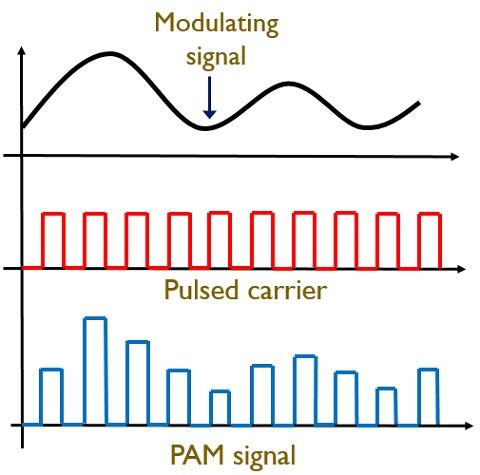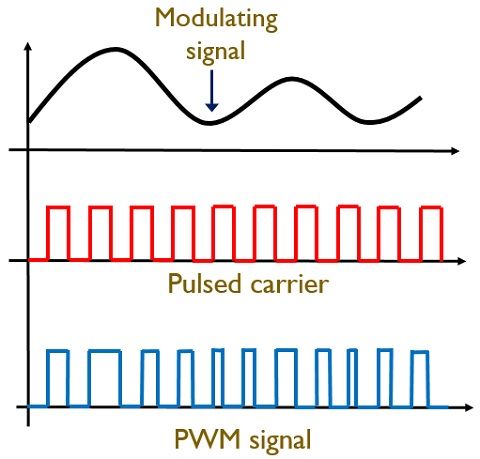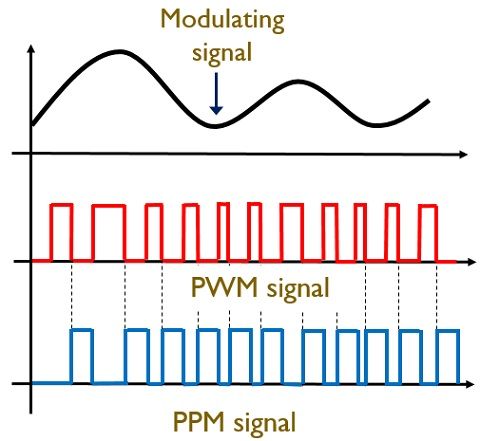PAM, PWM and PPM all three are analog pulse modulation techniques. The major difference between PAM, PWM and PPM lies in the parameter of a pulsed carrier that varies according to the modulating signal.
In PAM, the amplitude of the pulsed carrier signal is varied according to the amplitude of analog modulating signal. In PWM, the width of the pulses of the carrier wave is varied according to the modulating signal. As against, in PPM, the position of the pulses shows variation according to the modulating signal.
These are known as analog pulse modulation techniques because a pulsed carrier is varied according to analog message signal. Here, in this article, we will discuss other important factors that differentiate the three.
Content: PAM Vs PWM Vs PPM
Comparison Chart
| Basis for Comparison | PAM | PWM | PPM |
|---|---|---|---|
| Varying parameter | Amplitude | Width | Position |
| Immunity towards noise | Low | High | High |
| Signal to noise ratio | Low | Moderate | Comparitively high |
| Need of synchronization pulse | Not exist | Not exist | Exist |
| Bandwidth dependency | On pulse width | On rise time of pulse | On rise time of pulse |
| Transmission power | Variable | Variable | Constant |
| Bandwidth requirement | Low | High | High |
| Similarity of implementation | Similar to AM | Similar to FM | Similar to PM |
| Synchronization between Transmitter and Receiver | Not needed | Not needed | Needed |
Definition of PAM
PAM stands for pulse amplitude modulation. It is a modulation technique in which the amplitude of the pulsed carrier signal is changed according to the amplitude of the message signal. The figure given below represents a PAM signal:
As we can see in the figure shown above that the amplitude of the pulses is varying with respect to the amplitude of analog modulating signal, like in case of amplitude modulation. But the major difference is that unlike AM, here the carrier wave is a pulse train rather than continuous wave signal.
Definition of PWM
PWM is an acronym used for pulse width modulation. In PWM the width of the pulses is varied according to the amplitude of the message signal. The figure below shows the pulse width modulated signal:
As we can see that unlike PAM, in this technique the amplitude of the signal is constant and only the width is varying. PWM technique is similar to frequency modulation because, by the variation in the width of the pulses, the frequency of the pulses in the PWM signal shows variation.
Definition of PPM
PPM is used for pulse position modulation. It is a technique in which the position of the pulses is changed in accordance with the amplitude of the modulating signal. The figure below shows the PPM signal:
Here the pulse amplitude and the pulse width are the two constant that does not show variation with the amplitude of the modulating signal but only the position shows variation. It is to be noted here that the position of the pulse changes according to the reference pulses. And these reference pulses are nothing but PWM pulses. Basically, the falling edge of PWM pulses acts as the starting of the PPM pulses.
Key Differences Between PAM, PWM and PPM
- A factor that generates a key difference between PAM, PWM and PPM, is that in PAM amplitude of the pulse shows proportionality with the amplitude of modulating signal.
In PWM width of the pulses shows proportionality with the amplitude of the message signal. Whereas in PPM the position of the pulses is proportional to the amplitude of analog modulating signal. - PAM technique shows low immunity towards the noise. As against PWM and PPM has low noise interference factor because their noise immunity is high.
- In PAM and PWM techniques transmitter and receiver, synchronization is not required.
But PPM technique needs synchronization between transmitter and receiver section. - The SNR is low in case of pulse amplitude modulated signals while it is moderate in case of pulse width modulated signals and highest in case of pulse position modulated signals.
- The transmission power in case of PAM and PWM is variable due to variation in amplitude and width respectively.
However, it is constant in case of PPM because both amplitude and width are constant in case of PPM. - In PAM, transmission channel bandwidth relies on the pulse width. But in case of PWM and PPM, rise time of the pulse is a factor on which the transmission channel bandwidth depends.
- As the position of the pulses is changed in PPM, therefor it requires synchronization pulses. While both PAM and PWM do not require synchronization pulses.
- All PAM, PWM and PPM show similarity in implementation with AM, FM and PM respectively.
- The bandwidth requirement is low in case of PAM but is comparatively high in case of PWM and PPM.
Conclusion
Also, PAM systems are complex in implementation as compared to PWM and PPM systems.
